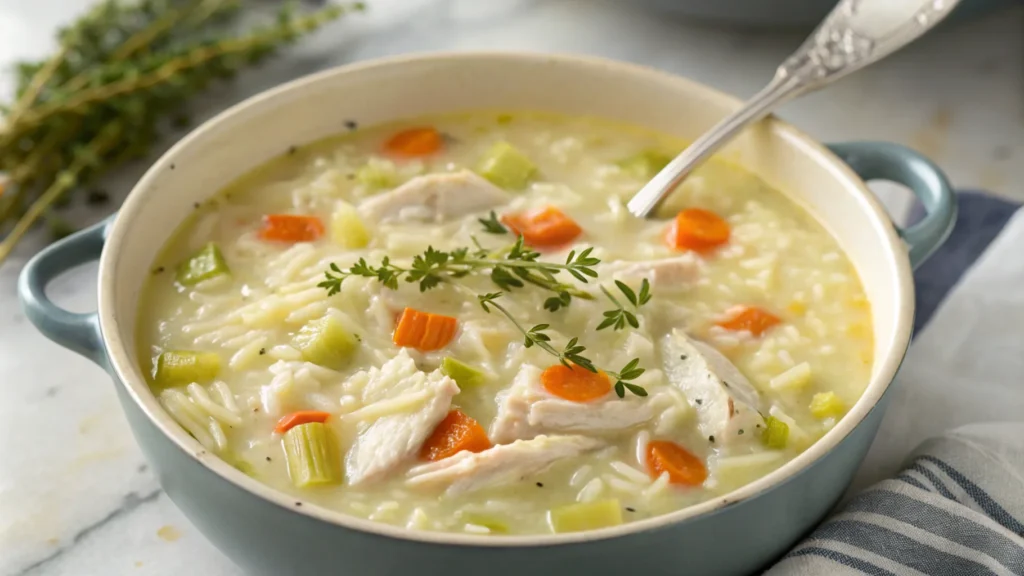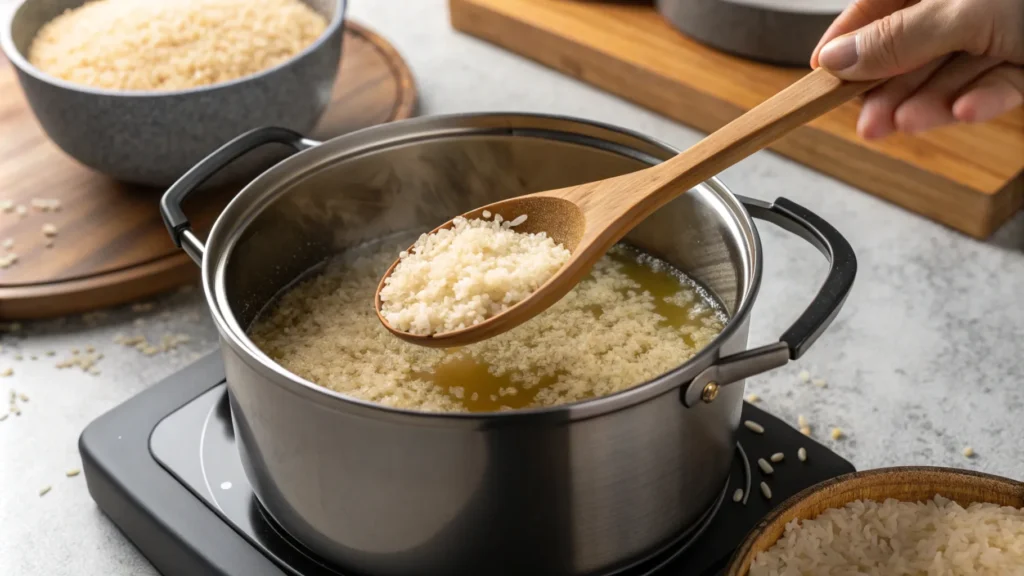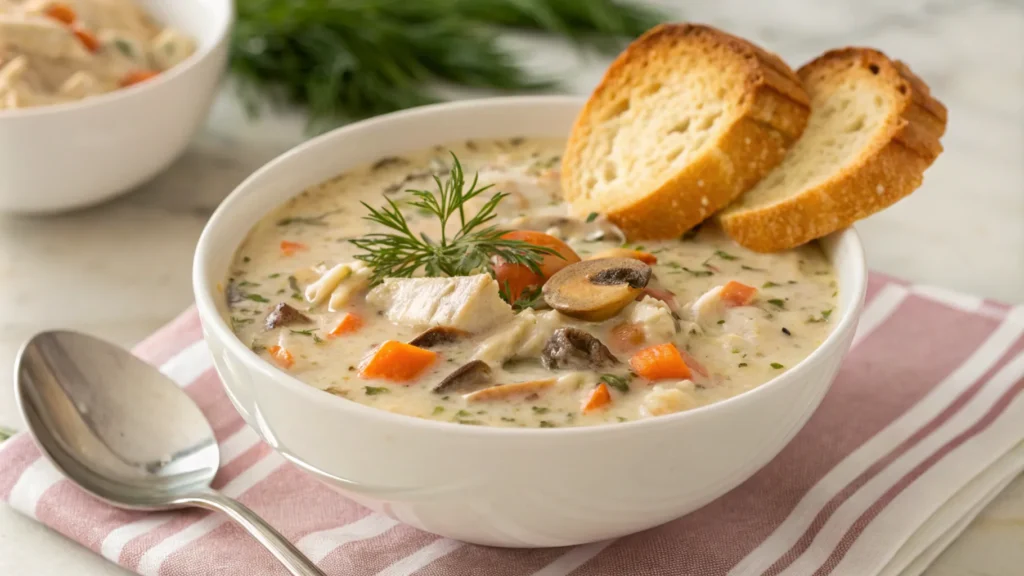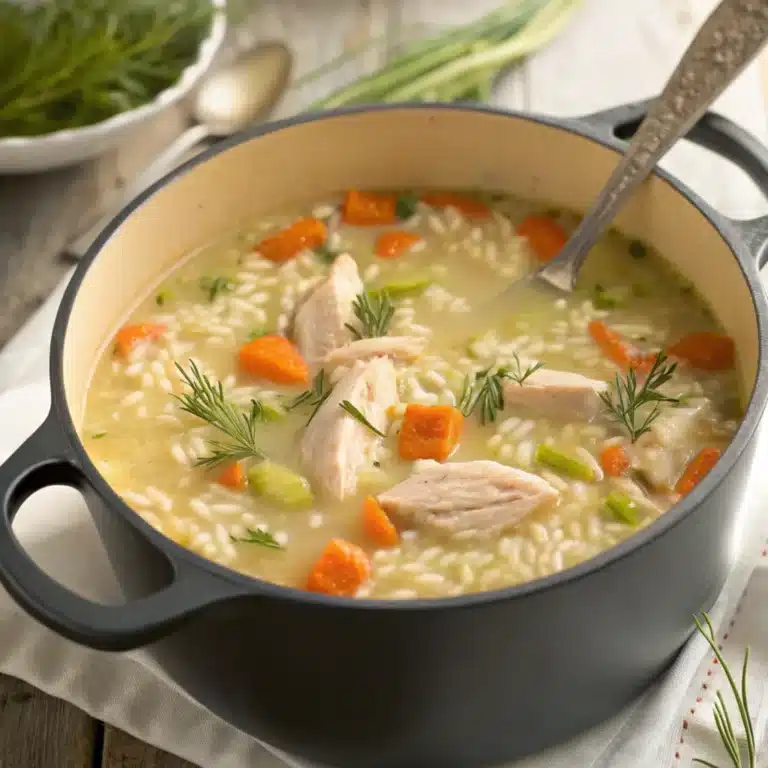Soups are a comforting and versatile dish enjoyed worldwide. Still, one question often arises: Why do people put rice in soup? From historical traditions to practical reasons, including rice in soups is more than just a culinary choice. In this article, we’ll uncover this practice’s roots, discover its many reasons, and learn how rice transforms ordinary soups into hearty meals. Along the way, we’ll discuss best practices for using rice in soup and answer some common questions about this humble ingredient.
Table of Contents
Historical and Cultural Roots of Adding Rice to Soup
The Origins of Rice in Soup
The practice of adding rice to soup dates back centuries, deeply rooted in culinary traditions across the globe. In Asian cuisines, rice has been a staple ingredient, making its way into iconic dishes like congee and rice noodle broths. These dishes aren’t just meals—they’re a part of the cultural fabric, symbolizing sustenance and togetherness.
In the Mediterranean and Middle Eastern regions, soups featuring rice—like avgolemono and lentil-rice blends—showcase how rice improves both flavor and texture. These dishes often celebrate the simplicity of ingredients, turning everyday staples into extraordinary meals.

Cultural Significance Across the World
Rice in soup also holds cultural significance in many societies. In some countries, it’s associated with comfort and healing. Consider the popularity of chicken and rice soup as a go-to remedy for colds. Similarly, in Japan, zosui—a rice and soup hybrid—is a dish served during illness recovery and is believed to nourish and rejuvenate the body.
Celebratory dishes also highlight the importance of rice in soups. During the Lunar New Year in China, dishes like rice soup symbolize prosperity and abundance, bringing families together to enjoy a shared meal.
From its historical origins to its symbolic importance, the presence of rice in soup is a testament to how food reflects culture and tradition. It’s fascinating to see how this practice connects different parts of the world, making a simple bowl of soup a universal comfort.
Practical Reasons for Adding Rice to Soup
Nutritional Benefits of Including Rice
When people ask, ‘Why do people add rice to soup?’ one of the key reasons is its nutritional benefits. Rice is a great source of energy because it’s rich in carbohydrates, which helps make soups more satisfying. When paired with proteins such as chicken or beans, rice creates a balanced dish, transforming a basic soup into a wholesome meal.
Rice also provides essential vitamins and minerals, like manganese and magnesium, that promote overall health. In contrast to other thickeners, like cream or flour, rice offers a healthier alternative that’s gluten-free and easy to digest, making it ideal for people with dietary restrictions.
Economic and Accessibility Factors
Let’s not forget how practical rice is! It’s one of the most affordable staples worldwide, making it a go-to ingredient for families on a budget. A handful of rice can stretch a soup pot, increasing portions without significantly reducing costs.
Additionally, rice is easily stored and widely available, so it’s always on hand when whipping a quick meal. Whether you’re making a simple chicken and rice soup or a hearty lentil-rice stew, this ingredient helps create both nutritious and economical dishes.
From boosting a soup’s nutrient profile to being a wallet-friendly choice, it’s clear why rice is special in kitchens worldwide. Cooks everywhere maximize flavor, texture, and cost-effectiveness by adding it to soups.
Types of Soups Featuring Rice
Classic Soups That Use Rice
Some of the most beloved soups around the world feature rice. Take chicken and rice soup, for example—this classic comfort food is a staple in many households, especially during colder months or when someone is under the weather. Tender chicken, flavorful broth, and soft rice create a warm, satisfying dish.
Lentil and rice soup is another fan favorite, known for its earthy taste and high protein content. In Greek cuisine, avgolemono soup combines rice, chicken, and a lemony egg mixture to create a creamy, tangy dish that’s both hearty and refreshing.
Innovative Rice Soup Recipes
Modern chefs and home cooks are constantly reinventing rice soups with unique twists. Fusion dishes like coconut curry rice soup marry Asian and Caribbean flavors, blending rice with spices, vegetables, and creamy coconut milk for a rich, aromatic meal.
For gluten-free options, rice is the perfect grain to replace pasta in minestrone or barley in vegetable soups. Its versatility allows for endless creativity, making rice an indispensable ingredient in traditional and contemporary recipes.
From cherished classics to innovative creations, rice-based soups inspire cooks worldwide. Whether for tradition or experimentation, rice remains a star ingredient in countless soup recipes, showing why people consistently reach for it when making a flavorful soup pot.

How to Add Rice to Soup: Best Practices
Should You Cook Rice Before Adding It to Soup?
When preparing soup, one common question is, “Should I cook the rice before adding it to the pot?” The answer depends on your goals for texture and cooking time. Cooking the rice beforehand allows for better control of its consistency, ensuring it doesn’t get mushy. It’s also a great option if you’re using leftover rice or need to speed up the cooking process.
On the other hand, adding uncooked rice directly to the soup lets the grains absorb the flavors of the broth. This method works wonderfully in recipes like chicken and rice soup, where the rice soaks up the savory essence of the stock. However, timing is crucial—add the rice early enough to cook through but not so soon that it disintegrates.
For more ideas on incorporating rice into soups, check out this recipe for French Onion Soup with Rice on Masterly Recipes: French Onion Soup with Rice.
Tips for Perfect Rice Soup Consistency
Nobody wants mushy rice ruining their soup! To achieve the perfect consistency, consider the type of rice you’re using. Long-grain varieties like basmati or jasmine hold their shape better, while short-grain rice tends to break down and thicken the soup.
If you’re meal-prepping, store the cooked rice separately and add it to the soup just before reheating. This prevents the grains from absorbing too much liquid over time. Remember to always adjust your soup’s liquid content if adding uncooked rice, as the grains will absorb a significant amount of broth.
Mastering these techniques Ensures your soups turn out delicious every time, with rice cooked to perfection.
Creative Twists on Rice Soup Recipes
Adding Unique Ingredients to Rice Soups
When thinking about why people put rice in soup, it’s not just about tradition or practicality—it’s also about creativity. Adding unexpected ingredients can transform a basic rice soup into something exciting. For instance, try mixing in coconut milk and curry spices to create a Thai-inspired rice soup. The rich, creamy base pairs beautifully with the rice, giving the dish a flavorful twist.
You can also experiment with proteins like shrimp or tofu or add vegetables like bok choy and bell peppers for a vibrant and nutritious meal. Even a dash of citrus, such as lime or lemon, can brighten the flavors and Promote the dish.
Fusion-Style Rice Soups
Fusion recipes are another way to bring new life to rice soups. Combine Mexican flavors by adding black beans, corn, and chipotle peppers to a tomato-based broth with rice. Alternatively, give your rice soup an Italian touch with parmesan cheese, basil, and a hint of garlic.
These creative twists highlight rice’s versatility, which is why it remains a favorite ingredient for soups. Its ability to adapt to global flavors makes it a must-have in any kitchen.
Tips for Serving and Storing Rice Soup
Serving Rice Soup the Right Way
Serving rice soup is an opportunity to get creative. Garnish your soup with fresh herbs like parsley or cilantro for added color and flavor. If you’re serving a creamy rice soup, a drizzle of olive oil or a sprinkle of grated cheese can Improve the presentation.
For spicy soups, top with sliced jalapeños or a dollop of sour cream. These simple touches make a significant impact, taking your rice soup from ordinary to extraordinary.
Storing and Reheating Rice Soup
Proper storage is essential to maintain the quality of your rice soup. Store leftovers in an airtight container in the fridge, separating the rice and soup if possible to avoid mushiness. When reheating, add a splash of broth or water to restore the consistency.
Rice soup also freezes well, but it’s best to freeze the broth and rice separately to preserve texture. Following these tips Ensures that your soup remains just as delicious the second time around.
These serving and storing strategies show why rice in soup is a practical and delicious choice. Whether it’s fresh off the stove or reheated for later, rice soup continues to delight with its comforting flavors and satisfying texture.
FAQs
Why Do Some People Avoid Adding Rice?
While rice is a popular choice for soups, some people avoid it due to dietary preferences or restrictions. For those watching their carb intake, alternatives like cauliflower rice or zucchini noodles can provide a similar texture without the carbohydrates. Others may skip rice because they prefer lighter, broth-based soups.
Can You Substitute Rice With Other Ingredients?
If rice isn’t available, there are plenty of substitutes to try. Grains like quinoa, barley, or farro add a nutty flavor and hearty texture to soups. Pasta, such as orzo or ditalini, can also replace rice in many recipes, especially Italian-style soups.
Understanding these options highlights why so many people put rice in soup—it’s a versatile, easy-to-find ingredient that improves both flavor and nutrition. Whether you use rice or an alternative, the possibilities for customizing soups are endless.
For more recipe inspiration, check out other creative ideas on Masterly Recipes: discover All Recipes.
Does Rice Change the Taste of Soup?
Many cooks ask, “Does adding rice affect the flavor of soup?” The answer is yes but in a subtle way. Rice absorbs the flavors of the broth, enhancing the soup’s overall taste without overpowering it. At the same time, it brings a mild, nutty undertone that complements ingredients like chicken, vegetables, and spices.
However, the type of rice you choose can make a difference. For example, jasmine or basmati rice adds an aromatic element, while plain white rice keeps the flavors neutral. This versatility is one reason why people put rice in soup. It works with nearly any recipe!
What Is the Best Type of Rice for Soup?
The best type of rice for your soup depends on the dish. Like basmati or jasmine, long-grain rice holds its shape well and works great in broth-based soups. Short-grain varieties, such as arborio, break down more, making them ideal for creamy soups or thicker stews.
No matter the choice, rice adds texture and heartiness to soup, making it a favorite ingredient worldwide. It’s no wonder that rice continues to be a staple in kitchens everywhere.

Conclusion and Final Thoughts
Rice’s role in soup-making is far more significant than it seems. When considering why people put rice in soup, the answers span from cultural traditions to practical advantages. Whether enhancing nutrition, boosting flavor, or stretching a meal, rice is an ingredient that adds so much value.
The global appeal of rice soups shows how food connects us across cultures. From comforting chicken and rice soup to innovative fusion recipes, rice adapts beautifully to any culinary style. Its affordability and availability make it a reliable choice for weeknight dinners or special occasions.
The next time you make soup, think about the type of rice you want to use and how it can Promote your dish. And don’t forget to discover new recipes that celebrate this humble yet essential grain. For more cooking ideas, visit Masterly Recipes.
Rice transforms soup into something extraordinary—delicious, hearty, and endlessly versatile. It’s no surprise that people everywhere keep coming back to this classic combination.

